warning TOYOTA PRIUS C 2020 Owners Manual
[x] Cancel search | Manufacturer: TOYOTA, Model Year: 2020, Model line: PRIUS C, Model: TOYOTA PRIUS C 2020Pages: 600, PDF Size: 12.02 MB
Page 231 of 600

2314-5. Toyota Safety Sense C
4
Driving
PRIUS c_U
The system can detect the following:
P. 2 3 4
● Vehicles
● Pedestrians
■Pre-collision warning
When the system determines
that the possibility of a frontal
collision is high, a buzzer will
sound and a warning message
will be displayed on the multi-
information display to urge the
driver to take evasive action.
■Pre-collision brake assist
When the system determines that the possibility of a frontal colli-
sion with a vehicle or pedestrian is high, the system applies greater
braking force in relation to how strongly the brake pedal is
depressed.
PCS (Pre-Collision System)
The pre-collision system uses the front sensor to detect objects
( P. 231) in front of the vehicle. When the system determines
that the possibility of a front al collision with an object is h igh, a
warning operates to urge the driver to take evasive action and
the potential brake pressure is increased to help the driver av oid
the collision. If the system determines that the possibility of a
frontal collision with an object i s extremely high, the brakes are
automatically applied to help av oid the collision or help reduce
the impact of the collision.
The pre-collision system can b e disabled/enabled and the warnin g
timing can be changed. ( P. 2 3 4 )
Detectable objects
System functions
Page 232 of 600
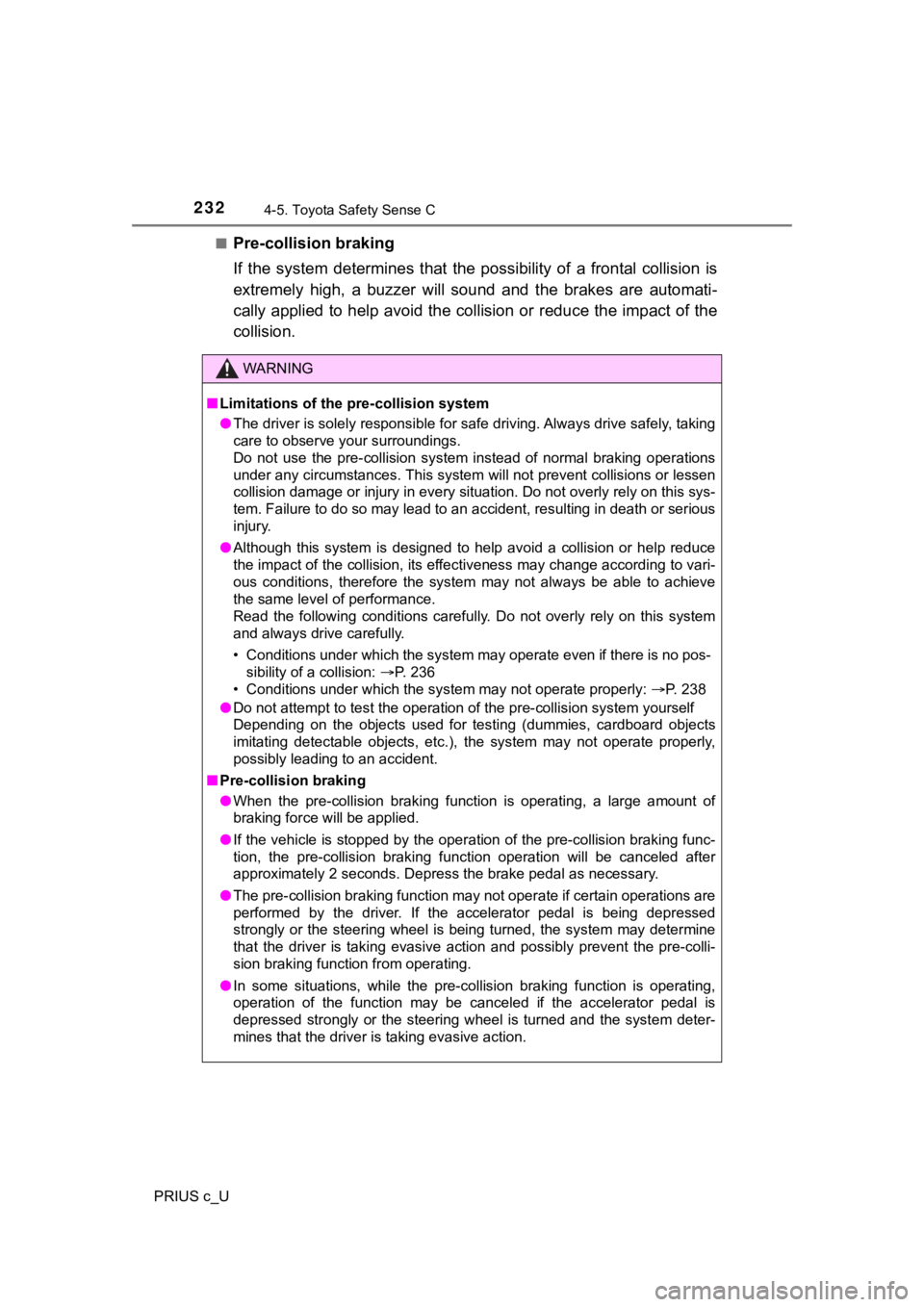
2324-5. Toyota Safety Sense C
PRIUS c_U■
Pre-collision braking
If the system determines that the
possibility of a frontal collision is
extremely high, a buzzer will sound and the brakes are automati -
cally applied to help avoid the collision or reduce the impact of the
collision.
WARNING
■ Limitations of the pre-collision system
● The driver is solely responsible for safe driving. Always drive safely, taking
care to observe your surroundings.
Do not use the pre-collision system instead of normal braking o perations
under any circumstances. This system will not prevent collision s or lessen
collision damage or injury in every situation. Do not overly re ly on this sys-
tem. Failure to do so may lead to an accident, resulting in dea th or serious
injury.
● Although this system is designed to help avoid a collision or h elp reduce
the impact of the collision, its effectiveness may change according to vari-
ous conditions, therefore the system may not always be able to achieve
the same level of performance.
Read the following conditions carefully. Do not overly rely on this system
and always drive carefully.
• Conditions under which the system may operate even if there is no pos-
sibility of a collision: P. 236
• Conditions under which the system may not operate properly: P. 238
● Do not attempt to test the operation of the pre-collision syste m yourself
Depending on the objects used for testing (dummies, cardboard o bjects
imitating detectable objects, etc.), the system may not operate properly,
possibly leading to an accident.
■ Pre-collision braking
● When the pre-collision braking function is operating, a large a mount of
braking force will be applied.
● If the vehicle is stopped by the operation of the pre-collision braking func-
tion, the pre-collision braking function operation will be canceled after
approximately 2 seconds. Depress the brake pedal as necessary.
● The pre-collision braking function may not operate if certain o perations are
performed by the driver. If the accelerator pedal is being depressed
strongly or the steering wheel is being turned, the system may determine
that the driver is taking evasive action and possibly prevent t he pre-colli-
sion braking function from operating.
● In some situations, while the pre-collision braking function is operating,
operation of the function may be canceled if the accelerator pedal is
depressed strongly or the steering wheel is turned and the syst em deter-
mines that the driver is taking evasive action.
Page 233 of 600
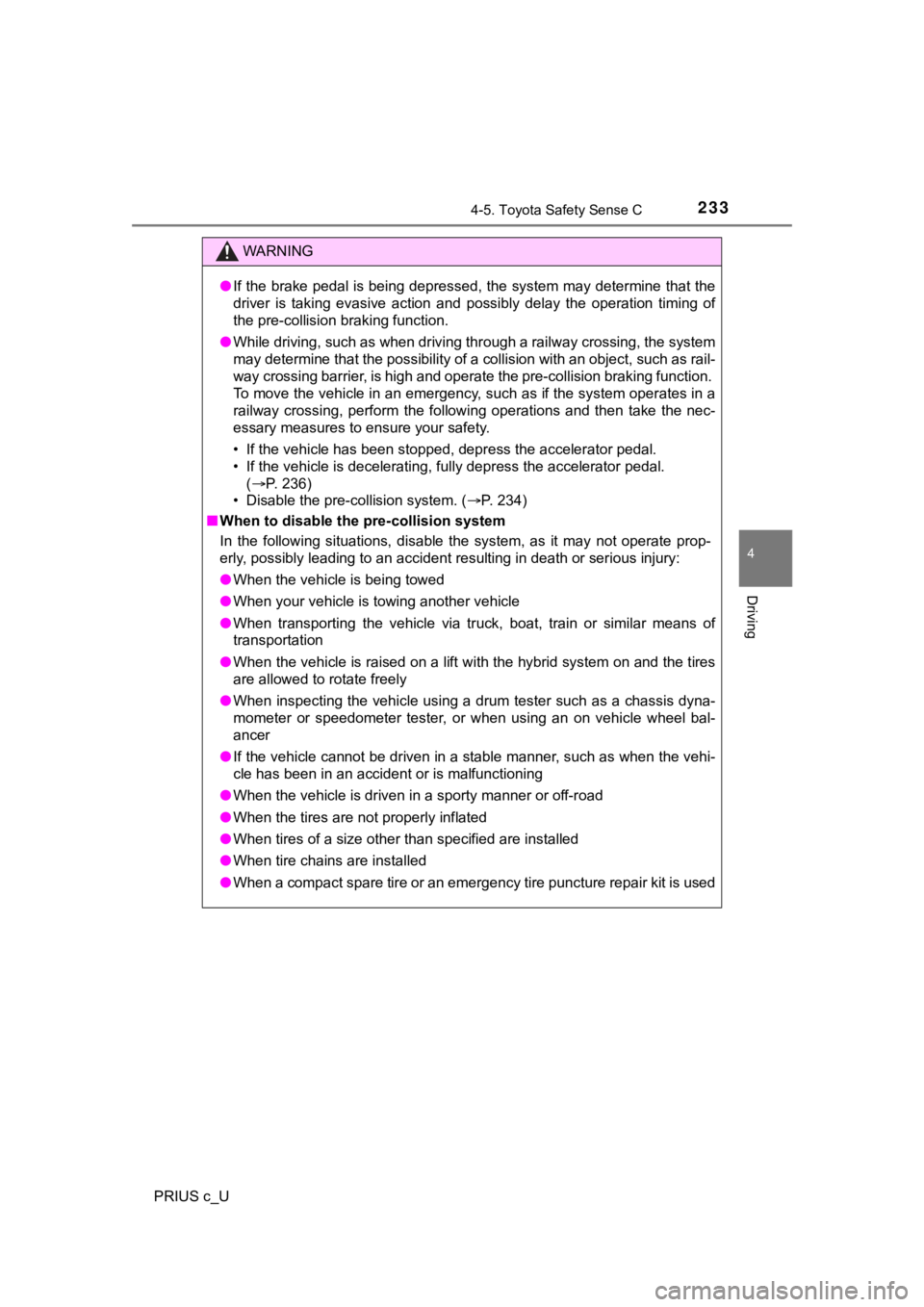
2334-5. Toyota Safety Sense C
4
Driving
PRIUS c_U
WARNING
●If the brake pedal is being depressed, the system may determine that the
driver is taking evasive action and possibly delay the operation timing of
the pre-collision braking function.
● While driving, such as when driving through a railway crossing, the system
may determine that the possibility of a collision with an objec t, such as rail-
way crossing barrier, is high and operate the pre-collision bra king function.
To move the vehicle in an emergency, such as if the system operates in a
railway crossing, perform the following operations and then take the nec-
essary measures to ensure your safety.
• If the vehicle has been stopped, depress the accelerator pedal.
• If the vehicle is decelerating, fully depress the accelerator pedal.
(P. 236)
• Disable the pre-collision system. ( P. 234)
■ When to disable the pre-collision system
In the following situations, disable the system, as it may not operate prop-
erly, possibly leading to an accident resulting in death or ser ious injury:
● When the vehicle is being towed
● When your vehicle is towing another vehicle
● When transporting the vehicle via truck, boat, train or similar means of
transportation
● When the vehicle is raised on a lift with the hybrid system on and the tires
are allowed to rotate freely
● When inspecting the vehicle using a drum tester such as a chass is dyna-
mometer or speedometer tester, or when using an on vehicle whee l bal-
ancer
● If the vehicle cannot be driven in a stable manner, such as when the vehi-
cle has been in an accident or is malfunctioning
● When the vehicle is driven in a sporty manner or off-road
● When the tires are not properly inflated
● When tires of a size other than specified are installed
● When tire chains are installed
● When a compact spare tire or an emergency tire puncture repair kit is used
Page 234 of 600

2344-5. Toyota Safety Sense C
PRIUS c_U■
Disabling the pre-collision system
Press the PCS switch fo
r 3 seconds or more.
The PCS warning light will turn
on and a message will be dis-
played in the multi-information
display, when the system is
turned off.
To enable the system, press the
PCS switch again.
The system is enabled each
time the power switch is turned
to the “ON” position (vehicles
without a smart key system) or
the power switch is turned to ON
mode (vehicles with a smart key
system).
■
Changing the pre-colli sion warning timing
Press the PCS switch to display the current warning timing on the
multi-Information display. Each time the PCS switch is pressed
while the current warning timing is displayed, the timing for the
warning changes as follows:
The warning timing setting is retained when the power switch is turned
off. However, if the pre-collision system is disabled and re-en abled, the
operation timing will return to the default setting (middle).
Early
Middle
This is the default setting.
Late
Changing settings of the pre-collision system
1
2
3
Page 235 of 600
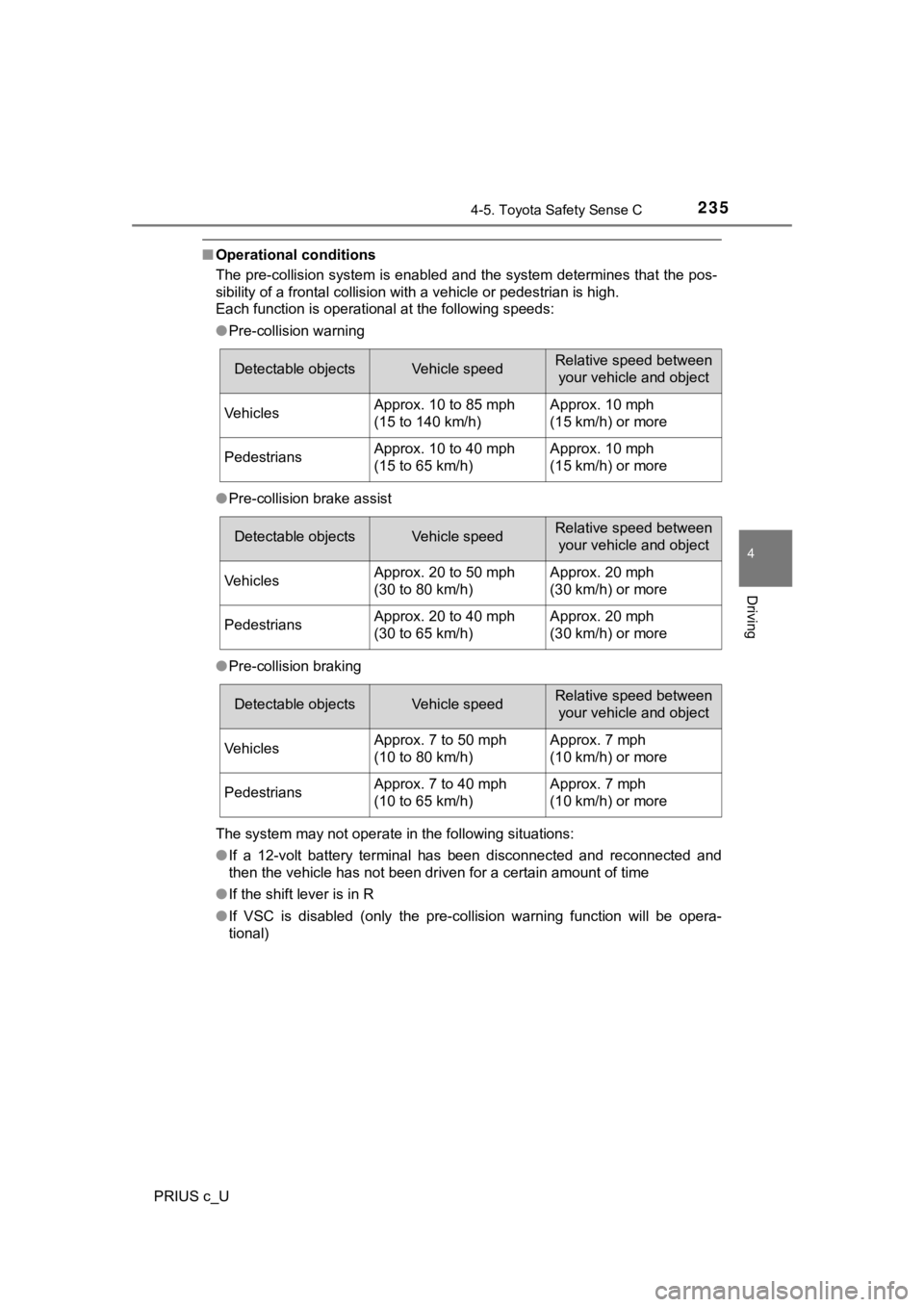
2354-5. Toyota Safety Sense C
4
Driving
PRIUS c_U
■Operational conditions
The pre-collision system is enabled and the system determines that the pos-
sibility of a frontal collision with a vehicle or pedestrian is high.
Each function is operational at the following speeds:
● Pre-collision warning
● Pre-collision brake assist
● Pre-collision braking
The system may not operate in the following situations:
● If a 12-volt battery terminal has been disconnected and reconnected and
then the vehicle has not been driven for a certain amount of ti me
● If the shift lever is in R
● If VSC is disabled (only the pre-collision warning function wil l be opera-
tional)
Detectable objectsVehicle speedRelative speed between your vehicle and object
VehiclesApprox. 10 to 85 mph
(15 to 140 km/h)Approx. 10 mph
(15 km/h) or more
PedestriansApprox. 10 to 40 mph
(15 to 65 km/h)Approx. 10 mph
(15 km/h) or more
Detectable objectsVehicle speedRelative speed between your vehicle and object
VehiclesApprox. 20 to 50 mph
(30 to 80 km/h)Approx. 20 mph
(30 km/h) or more
PedestriansApprox. 20 to 40 mph
(30 to 65 km/h)Approx. 20 mph
(30 km/h) or more
Detectable objectsVehicle speedRelative speed between your vehicle and object
VehiclesApprox. 7 to 50 mph
(10 to 80 km/h)Approx. 7 mph
(10 km/h) or more
PedestriansApprox. 7 to 40 mph
(10 to 65 km/h)Approx. 7 mph
(10 km/h) or more
Page 240 of 600
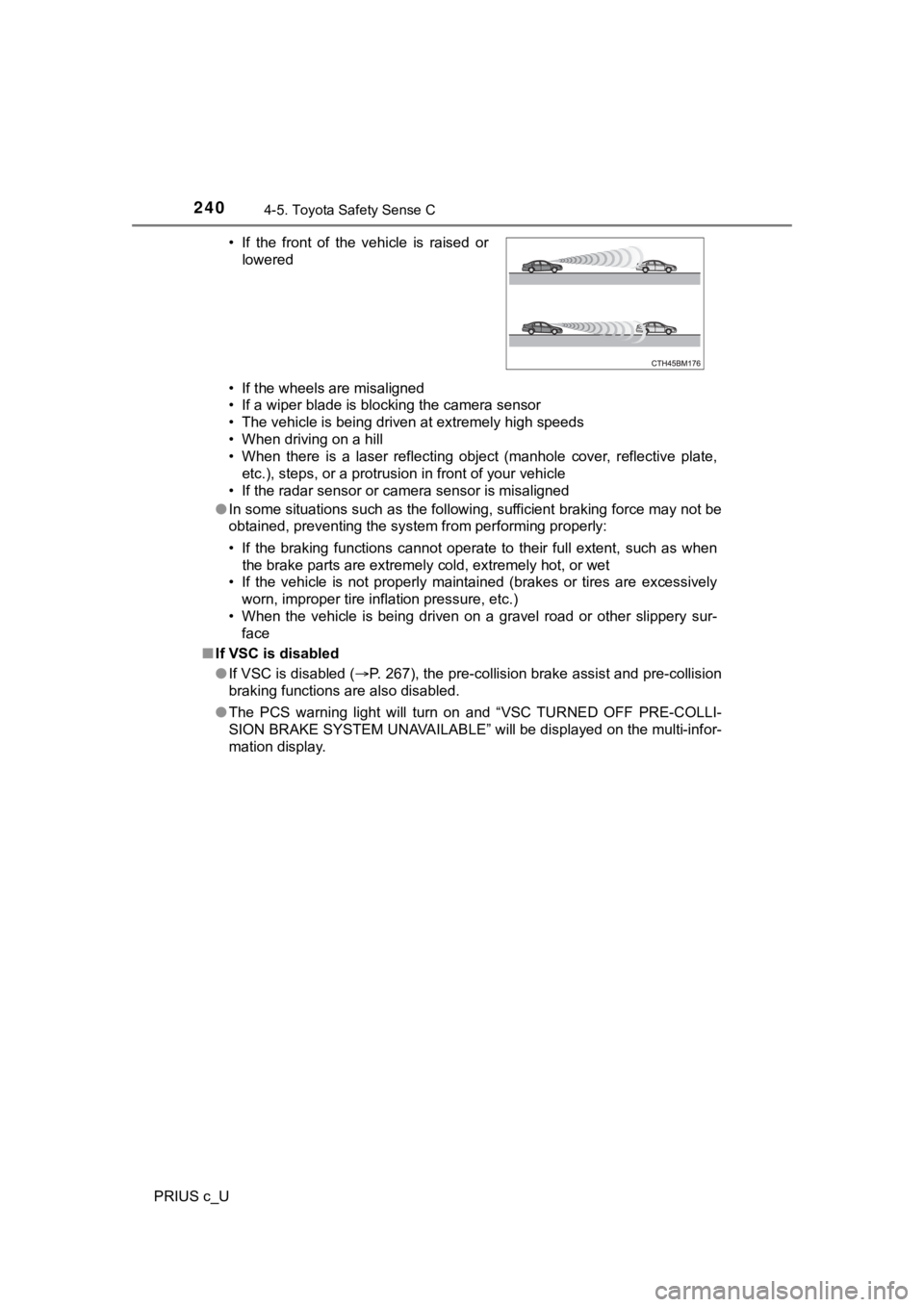
2404-5. Toyota Safety Sense C
PRIUS c_U• If the wheels are misaligned
• If a wiper blade is blocking the camera sensor
• The vehicle is being driven at extremely high speeds
• When driving on a hill
• When there is a laser reflecting object (manhole cover, reflec
tive plate,
etc.), steps, or a protrusion in front of your vehicle
• If the radar sensor or camera sensor is misaligned
● In some situations such as the following, sufficient braking fo rce may not be
obtained, preventing the system from performing properly:
• If the braking functions cannot operate to their full extent, such as when
the brake parts are extremely cold, extremely hot, or wet
• If the vehicle is not properly maintained (brakes or tires are excessively
worn, improper tire inflation pressure, etc.)
• When the vehicle is being driven on a gravel road or other sli ppery sur-
face
■ If VSC is disabled
●If VSC is disabled ( P. 267), the pre-collision brake assist and pre-collision
braking functions are also disabled.
● The PCS warning light will turn on and “VSC TURNED OFF PRE-COLL I-
SION BRAKE SYSTEM UNAVAILABLE” will be displayed on the multi-i nfor-
mation display. • If the front of the vehicle is raised or
lowered
Page 241 of 600
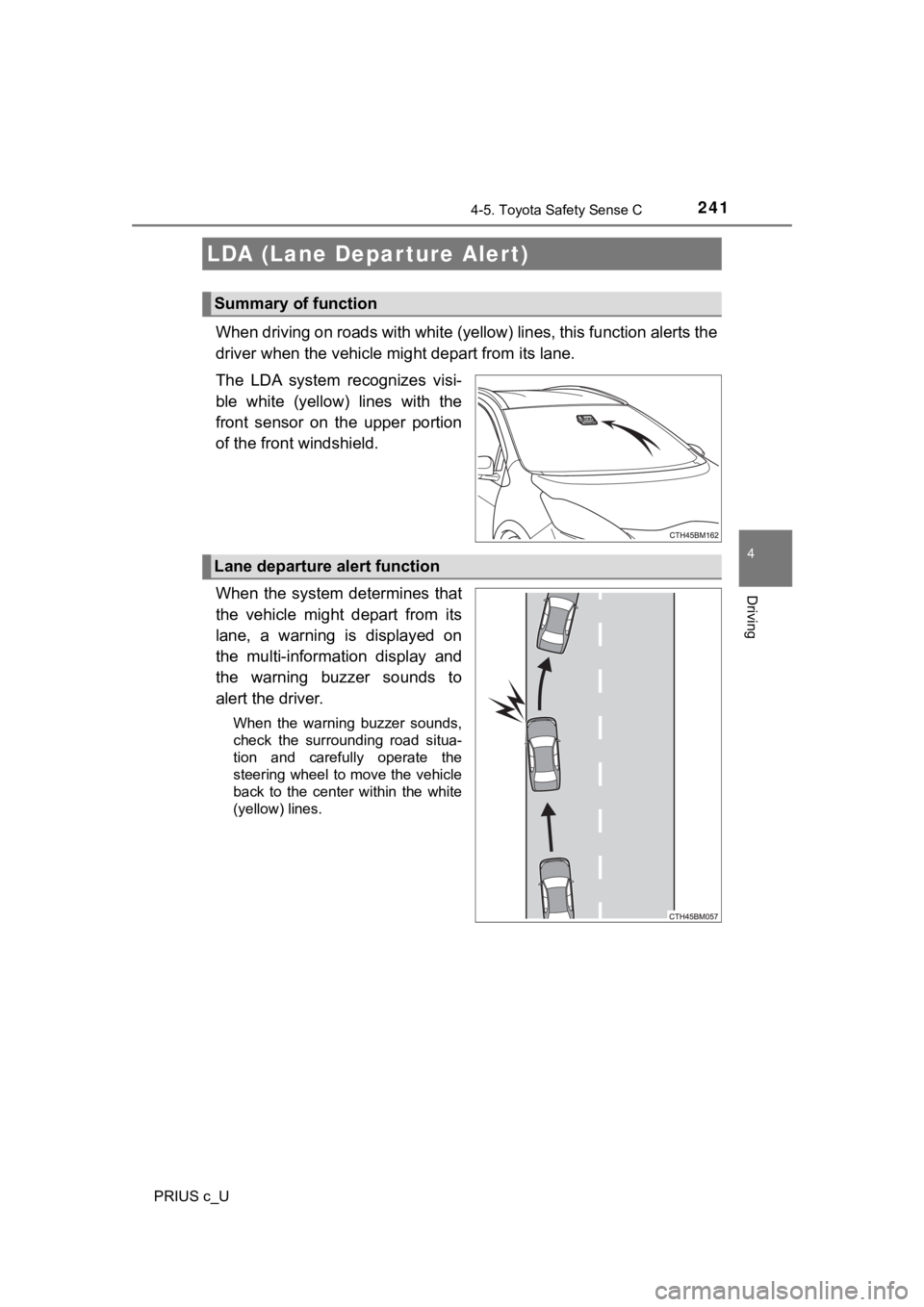
2414-5. Toyota Safety Sense C
4
Driving
PRIUS c_U
When driving on roads with white (yellow) lines, this function alerts the
driver when the vehicle mi ght depart from its lane.
The LDA system recognizes visi-
ble white (yellow) lines with the
front sensor on the upper portion
of the front windshield.
When the system determines that
the vehicle might depart from its
lane, a warning is displayed on
the multi-information display and
the warning buzzer sounds to
alert the driver.
When the warning buzzer sounds,
check the surrounding road situa-
tion and carefully operate the
steering wheel to move the vehicle
back to the center within the white
(yellow) lines.
LDA (Lane Depar ture Alert)
Summary of function
Lane departure alert function
Page 242 of 600
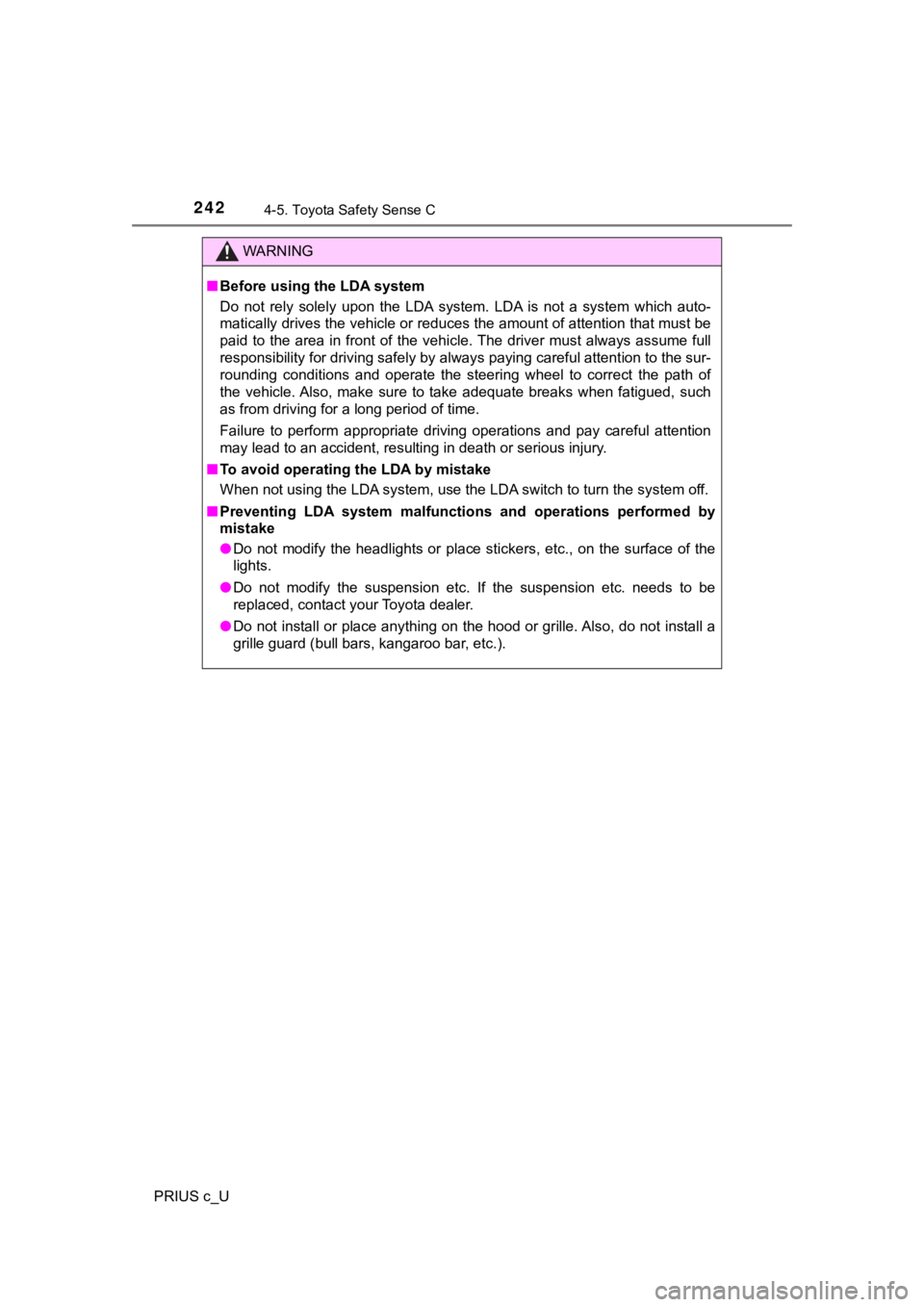
2424-5. Toyota Safety Sense C
PRIUS c_U
WARNING
■Before using the LDA system
Do not rely solely upon the LDA system. LDA is not a system which auto-
matically drives the vehicle or reduces the amount of attention that must be
paid to the area in front of the vehicle. The driver must alway s assume full
responsibility for driving safely by always paying careful atte ntion to the sur-
rounding conditions and operate the steering wheel to correct t he path of
the vehicle. Also, make sure to take adequate breaks when fatigued, such
as from driving for a long period of time.
Failure to perform appropriate driving operations and pay careful attention
may lead to an accident, resulting in death or serious injury.
■ To avoid operating the LDA by mistake
When not using the LDA system, use the LDA switch to turn the s ystem off.
■ Preventing LDA system malfunctio ns and operations performed by
mistake
● Do not modify the headlights or place stickers, etc., on the su rface of the
lights.
● Do not modify the suspension etc. If the suspension etc. needs to be
replaced, contact your Toyota dealer.
● Do not install or place anything on the hood or grille. Also, d o not install a
grille guard (bull bars, kangaroo bar, etc.).
Page 244 of 600

2444-5. Toyota Safety Sense C
PRIUS c_U
■Operation conditions
This function operates when all of the following conditions are met.
● LDA is turned on.
● Vehicle speed is approximately 32 mph (50 km/h) or more.
● System recognizes white (yellow) lines.
● Width of traffic lane is approximately 9.8 ft. (3 m) or more.
● Turn signal lever is not operated.
● Vehicle is driven on a straight road or around a gentle curve w ith a radius of
more than approximately 492 ft. (150 m).
● No system malfunctions are detected. ( P. 480)
■ Temporary cancellation of functions
When operation conditions are no longer met, a function may be temporarily
canceled. However, when the operation conditions are met again, operation
of the function is automatically restored.
■ Lane departure alert function
The warning buzzer may be difficult to hear due to external noi se, audio play-
back, etc.
■ White (yellow) lines are only on one side of road
The LDA system will not operate for the side on which white (yellow) lines
could not be recognized.
■ After the vehicle has been parked in the sun
The LDA system may not be available and a warning message may b e dis-
played for a while after starting off. When the temperature in the cabin
decreases and the temperature around the front sensor ( P. 226) becomes
suitable for its operation, the system will begin to operate.
Page 245 of 600
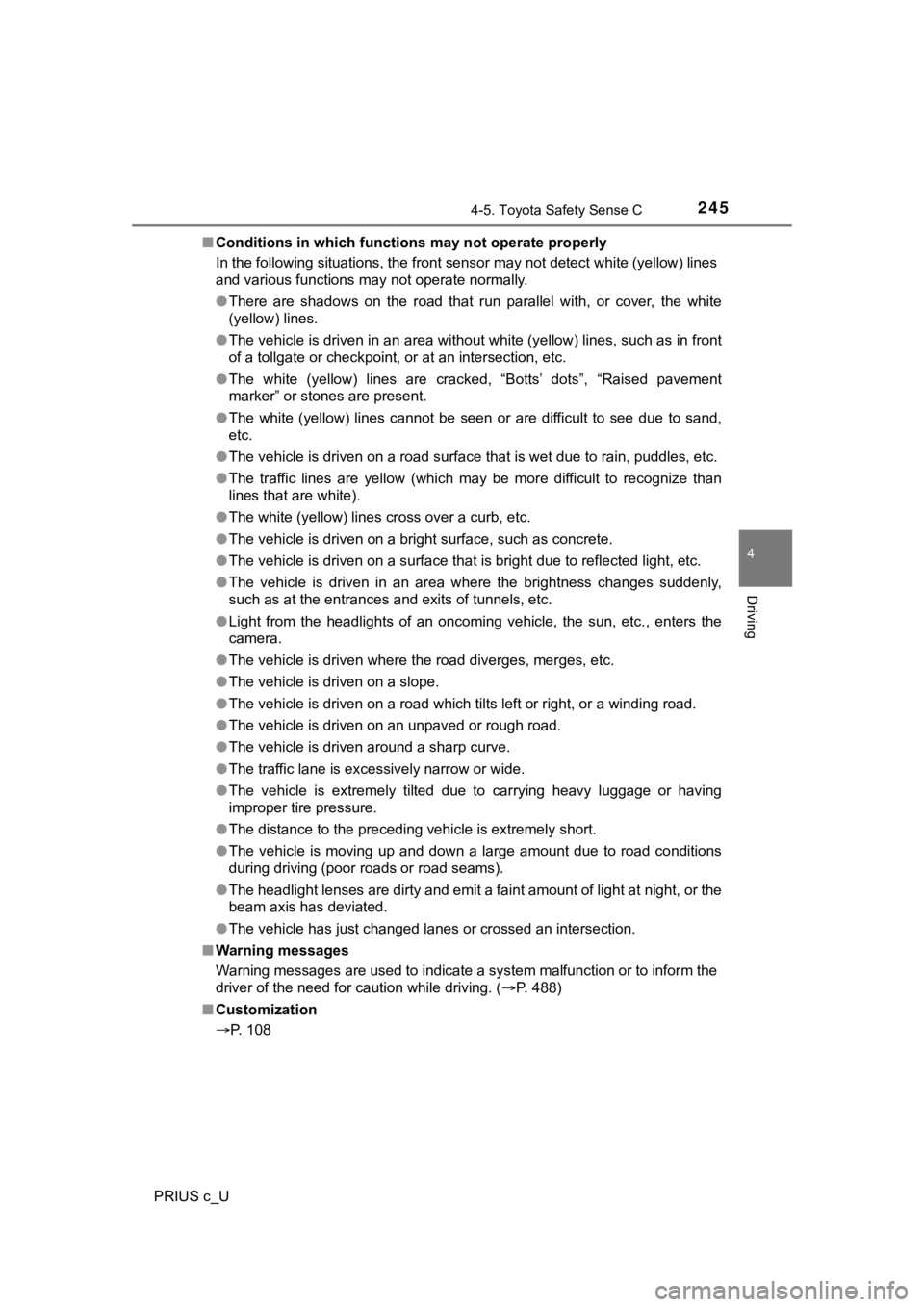
2454-5. Toyota Safety Sense C
4
Driving
PRIUS c_U■
Conditions in which functions may not operate properly
In the following situations, the front sensor may not detect wh ite (yellow) lines
and various functions may not operate normally.
● There are shadows on the road that run parallel with, or cover, the white
(yellow) lines.
● The vehicle is driven in an area without white (yellow) lines, such as in front
of a tollgate or checkpoint, or at an intersection, etc.
● The white (yellow) lines are cracked, “Botts’ dots”, “Raised pa vement
marker” or stones are present.
● The white (yellow) lines cannot be seen or are difficult to see due to sand,
etc.
● The vehicle is driven on a road surface that is wet due to rain , puddles, etc.
● The traffic lines are yellow (which may be more difficult to re cognize than
lines that are white).
● The white (yellow) lines cross over a curb, etc.
● The vehicle is driven on a bright surface, such as concrete.
● The vehicle is driven on a surface that is bright due to reflec ted light, etc.
● The vehicle is driven in an area where the brightness changes s uddenly,
such as at the entrances and exits of tunnels, etc.
● Light from the headlights of an oncoming vehicle, the sun, etc. , enters the
camera.
● The vehicle is driven where the road diverges, merges, etc.
● The vehicle is driven on a slope.
● The vehicle is driven on a road which tilts left or right, or a winding road.
● The vehicle is driven on an unpaved or rough road.
● The vehicle is driven around a sharp curve.
● The traffic lane is excessively narrow or wide.
● The vehicle is extremely tilted due to carrying heavy luggage or having
improper tire pressure.
● The distance to the preceding vehicle is extremely short.
● The vehicle is moving up and down a large amount due to road co nditions
during driving (poor roads or road seams).
● The headlight lenses are dirty and emit a faint amount of light at night, or the
beam axis has deviated.
● The vehicle has just changed lanes or crossed an intersection.
■ Warning messages
Warning messages are used to indicate a system malfunction or to inform the
driver of the need for caution while driving. ( P. 488)
■ Customization
P. 108